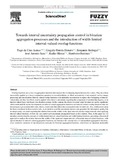Mostrar el registro sencillo del ítem
Towards interval uncertainty propagation control in bivariate aggregation processes and the introduction of width-limited interval-valued overlap functions
| dc.creator | Asmus, Tiago | es_ES |
| dc.creator | Pereira Dimuro, Graçaliz | es_ES |
| dc.creator | Bedregal, Benjamin | es_ES |
| dc.creator | Sanz Delgado, José Antonio | es_ES |
| dc.creator | Mesiar, Radko | es_ES |
| dc.creator | Bustince Sola, Humberto | es_ES |
| dc.date.accessioned | 2022-01-17T12:47:54Z | |
| dc.date.available | 2022-01-17T12:47:54Z | |
| dc.date.issued | 2021 | |
| dc.identifier.issn | 0165-0114 | |
| dc.identifier.uri | https://hdl.handle.net/2454/41791 | |
| dc.description.abstract | Overlap functions are a class of aggregation functions that measure the overlapping degree between two values. They have been successfully applied as a fuzzy conjunction operation in several problems in which associativity is not required, such as image processing and classification. Interval-valued overlap functions were defined as an extension to express the overlapping of interval-valued data, and they have been usually applied when there is uncertainty regarding the assignment of membership degrees, as in interval-valued fuzzy rule-based classification systems. In this context, the choice of a total order for intervals can be significant, which motivated the recent developments on interval-valued aggregation functions and interval-valued overlap functions that are increasing to a given admissible order, that is, a total order that refines the usual partial order for intervals. Also, width preservation has been considered on these recent works, in an intent to avoid the uncertainty increase and guarantee the information quality, but no deeper study was made regarding the relation between the widths of the input intervals and the output interval, when applying interval-valued functions, or how one can control such uncertainty propagation based on this relation. Thus, in this paper we: (i) introduce and develop the concepts of width-limited interval-valued functions and width limiting functions, presenting a theoretical approach to analyze the relation between the widths of the input and output intervals of bivariate interval-valued functions, with special attention to interval-valued aggregation functions; (ii) introduce the concept of (a,b)-ultramodular aggregation functions, a less restrictive extension of one-dimension convexity for bivariate aggregation functions, which have an important predictable behaviour with respect to the width when extended to the interval-valued context; (iii) define width-limited interval-valued overlap functions, taking into account a function that controls the width of the output interval and a new notion of increasingness with respect to a pair of partial orders (≤1,≤2); (iv) present and compare three construction methods for these width-limited interval-valued overlap functions, considering a pair of orders (≤1,≤2), which may be admissible or not, showcasing the adaptability of our developments. | en |
| dc.description.sponsorship | Supported by CNPq (311429/2020-3, 301618/2019-4), FAPERGS (19/2551-0001660) and the Spanish Ministries of Science and Technology and of Economy and Competitiveness (TIN2016-77356-P, PID2019-108392GB I00 (AEI/10.13039/501100011033) ), by UPNA (PJUPNA1926) and the Grant APVV-0052-18. | en |
| dc.format.extent | 39 p. | |
| dc.format.mimetype | application/pdf | en |
| dc.language.iso | eng | en |
| dc.publisher | Elsevier | |
| dc.relation.ispartof | Fuzzy Sets and Systems (2021) | |
| dc.rights | © 2021 The Authors. Creative Commons Attribution-NonCommercial-NoDerivatives 4.0 International | en |
| dc.rights.uri | http://creativecommons.org/licenses/by-nc-nd/4.0/ | |
| dc.subject | Admissible orders | en |
| dc.subject | Aggregation functions | en |
| dc.subject | Interval-valued aggregation functions | en |
| dc.subject | Interval-valued overlap functions | en |
| dc.subject | Overlap functions | en |
| dc.title | Towards interval uncertainty propagation control in bivariate aggregation processes and the introduction of width-limited interval-valued overlap functions | en |
| dc.type | info:eu-repo/semantics/article | en |
| dc.type | Artículo / Artikulua | es |
| dc.contributor.department | Estatistika, Informatika eta Matematika | eu |
| dc.contributor.department | Institute of Smart Cities - ISC | en |
| dc.contributor.department | Estadística, Informática y Matemáticas | es_ES |
| dc.rights.accessRights | info:eu-repo/semantics/openAccess | en |
| dc.rights.accessRights | Acceso abierto / Sarbide irekia | es |
| dc.identifier.doi | 10.1016/j.fss.2021.09.005 | |
| dc.relation.projectID | info:eu-repo/grantAgreement/ES/1PE/TIN2016-77356-P | en |
| dc.relation.projectID | info:eu-repo/grantAgreement/AEI/Plan Estatal de Investigación Científica y Técnica y de Innovación 2017-2020/PID2019-108392GB-I00/ES/ | en |
| dc.relation.publisherversion | http://doi.org/10.1016/j.fss.2021.09.005 | |
| dc.type.version | info:eu-repo/semantics/publishedVersion | en |
| dc.type.version | Versión publicada / Argitaratu den bertsioa | es |
| dc.contributor.funder | Universidad Pública de Navarra / Nafarroako Unibertsitate Publikoa |






